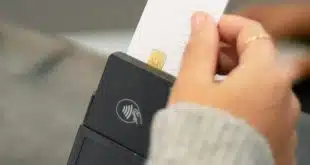For years, leading U.S.-based terminal maker VeriFone Systems Inc. has been anticipating the move away from magnetic-stripe cards to the Europay-MasterCard-Visa (EMV) chip card standard.
The conversion is guaranteed to induce a buying spree for point-of-sale hardware as well as the software that runs it. That’s the happy circumstance VeriFone finds itself in a year ahead of a major EMV deadline. “EMV migration continues to drive sales for VeriFone,” VeriFone chief executive Paul Galant said last month during the company’s earnings conference call for fiscal 2014’s third quarter ended July 31.
Fourteen large retailers upgraded their payment systems to VeriFone’s EMV-capable MX 900 line of terminals, including one global retailer that ordered 40,000 units. VeriFone wouldn’t identify the retailer.
“More than 80% of products shipped in [the] U.S. were EMV-capable, up from approximately 70% in the first quarter,” Galant said.
While Visa Inc. announced the first U.S. chip card adoption plan more than three years ago, the conversion is only now getting into high gear. About 30% of U.S. terminals currently are capable of accepting EMV cards, according to Galant. Big-box retailers have led the way, but many other merchant sectors have barely started upgrading their POS systems, if at all.
“So, still an awful lot of the terminals need to be converted,” he said, noting that the 14 recent MX 900 terminal buyers did not include hospitality merchants or quick-service restaurants “that we believe are still coming.”
The major payment networks have set a so-called liability shift for October 2015 in which the party in a card transaction that cannot support EMV—issuer or merchant—will be responsible for any resulting counterfeit card fraud. Fuel-pump operators have two years beyond that to convert.
Galant also noted that virtually all of VeriFone’s EMV terminals include a near-field communication (NFC) chip, which will enable contactless payments between these terminals and smart phones. NFC is one of the major technologies powering Apple Inc.’s new iPhone 6 and Apple Pay service (“Can Apple Save Mobile Wallets?”).
“A migration to EMV will certainly significantly increase the installed base of NFC terminals and the potential for the use of NFC in payment and commerce moving forward,” he said.
Boosted by sales of its EMV equipment in addition to strong business from U.S. petroleum retailers, VeriFone reported North American revenues of $129.8 million, up 12.1% from $115.8 million in fiscal 2013’s third quarter. VeriFone also picked up business in France, Germany, Canada, and China.
The brisk U.S. EMV terminal sales likely contributed to an increase in the share of hardware-based “system solutions” versus services such as data protection and processing as a percent of VeriFone’s total sales in the quarter.
System solutions have been mostly declining in share in recent years, but they brought in $299.4 million in the third quarter, up 19.4% from a year earlier, while services revenues grew 6.8% to $176.5 million. Those figures boosted system solutions to 62.9% of sales versus 60.3% in fiscal 2013’s third quarter.
VeriFone’s total third-quarter revenues grew 14.4% to $475.9 million. The company reported a net loss attributable to shareholders of $29 million versus a loss of $1.9 million a year earlier. Adjusted for one-time gains and expenses, net income grew 71% to $45 million from $26 million in the year-earlier quarter.
—Jim Daly





